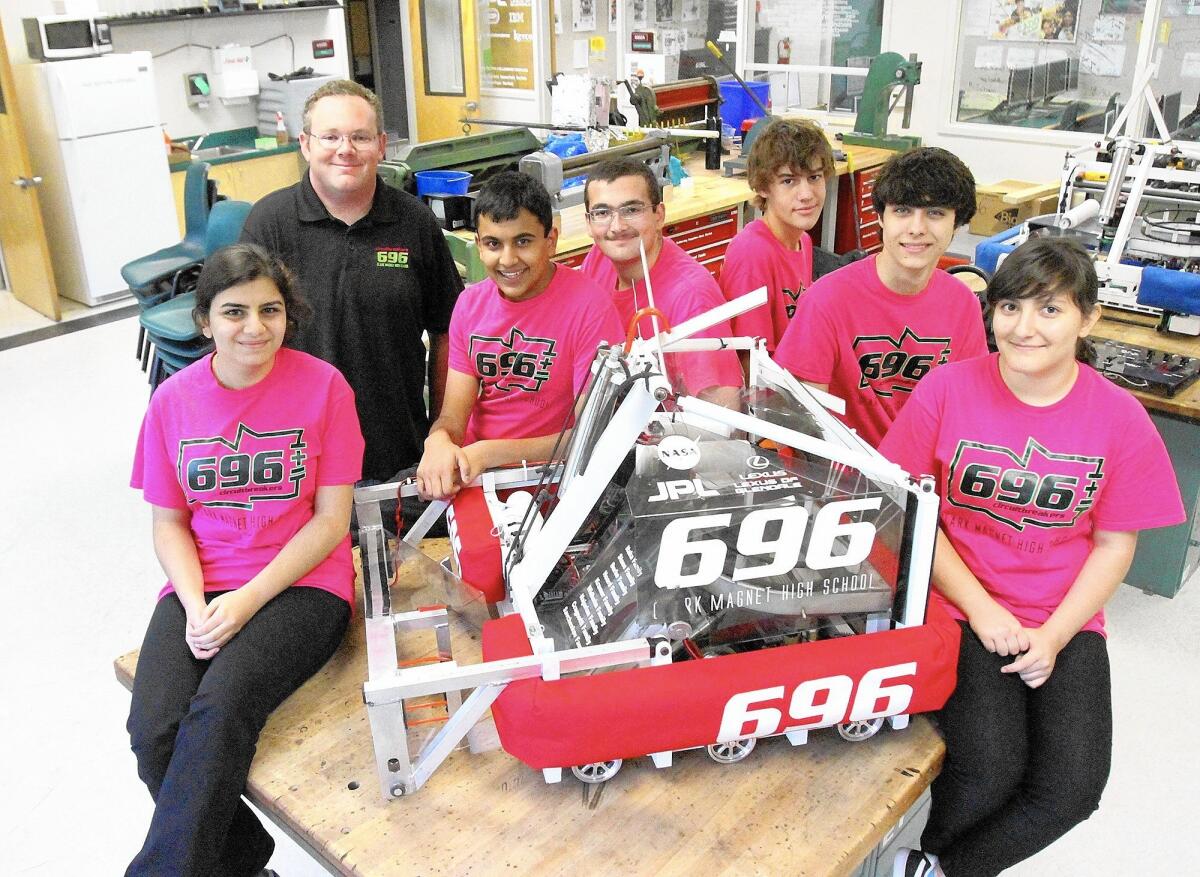Clark graduate guides his alma mater’s engineering program

Some of the members of the Clark Magnet School robotics team are, from left, Cynthia Mirzaie, engineering teacher David Black, vice president Saikiran Ramanan, Jack Najarian, Shay Sackett, Jatej Zampach and Miriam Grigoryan, seen here in their engineering lab at Clark Magnet School in Glendale on Monday
At the helm of Clark Magnet High School’s burgeoning engineering program is one of the school’s own graduates: 28-year-old David Black, who now sits on a national committee working to lay down the first-ever standards in computer-aided manufacturing.
As one of 16 people on the committee and the only high school teacher involved, the standards for the National Institute of Metalworking Skills will shape the way that students and professionals earn credentials in the field.
With the right skills and credentials, Black knows students can secure high paying gigs, and he keeps his hand on the pulse of industry trends to engage local students in computer-aided design and manufacturing.
At Clark Magnet, engineering courses involve high-tech machines and software programs that have evolved from the old wood and metal shop classes offered in decades past.
Despite falling out of favor in the 1980s and ‘90s, shop is making a resurgence on a highly technical level, and as an educator, Black is working to stay on the cutting edge.
He grew up in La Crescenta, attending Dunsmore Elementary and Rosemont Middle School.
In the seventh- and eighth-grades, he discovered his interest in mechanical drawing, model airplanes and radio controlled vehicles.
In 2000, he chose to attend Clark Magnet, then a two-year old science and technology magnet over Crescenta Valley High.
He also joined Clark’s first robotics team, which he now directs.
Upon graduating Clark in 2004, he pursued his mechanical engineering studies at Cal Poly Pomona. After completing college, Black received a call from Principal Doug Dall asking him to return and teach.
A couple teachers had retired and Black was offered to teach engineering classes and grow the program. He took the offer and began teaching in the fall of 2010.
Not long after, Dall challenged Black to create a professional lab.
“It needs to look like a lab at JPL,” Black recalled Dall telling him. “That was kind of a challenge to me. It was really, a dream come true.”
Today, the school is one of Glendale Unified’s shining jewels, and the engineering program is a regional example of a successful high school program featuring industry standard equipment and software in a lab where students churn out anything they can dream up.
“They have to have that hands-on element in their classes with a philosophy of learning by doing,” Black said. “Things I remember best are the things that I did — projects that I made with my hands and took home. It’s usually a higher order of thinking that builds a deeper understanding for the student.”
Students have built radio controlled quadcopters, amphibious bicycles, sculptures, architectural models and robotic prosthetic limbs.
“When students see what’s possible using the equipment in the lab, their ideas just flourish,” Black said.
Each year, the school hosts an open house where Black said professional visitors see the machinery Clark students work with and lamented that even their workplace does not have the equipment Clark does.
One man, in attempting to spot a weakness in the lab, pointed out to Black that he didn’t see a laser cutter among the nearly 15 3-D printers and several more computer numerical control machines.
“I told him, ‘That’s in the building downstairs,’” Black said.
Black has also been pivotal in securing grants for Clark.
Beginning in 2013, Clark received its first of two competitive Specialized Secondary Program grants after Black applied for them, worth $50,000 and $100,000, respectively, from the state to build a new computer-aided manufacturing program.
The money has helped the school purchase new laptop computers and monitors to run advanced design and manufacturing software and a computer numerically controlled lathe so far.
Overall, of Clark’s program, “It’s taken us a long time and a lot of grants — a lot of hard work,” Black said.
So far, Black can see the first signs of the effort paying off with his former students who are now in college and returning to tell him they feel far ahead of their peers in their college programs because of the experience they had at Clark.
“This is a real gem here in the Crescenta Valley,” he said.